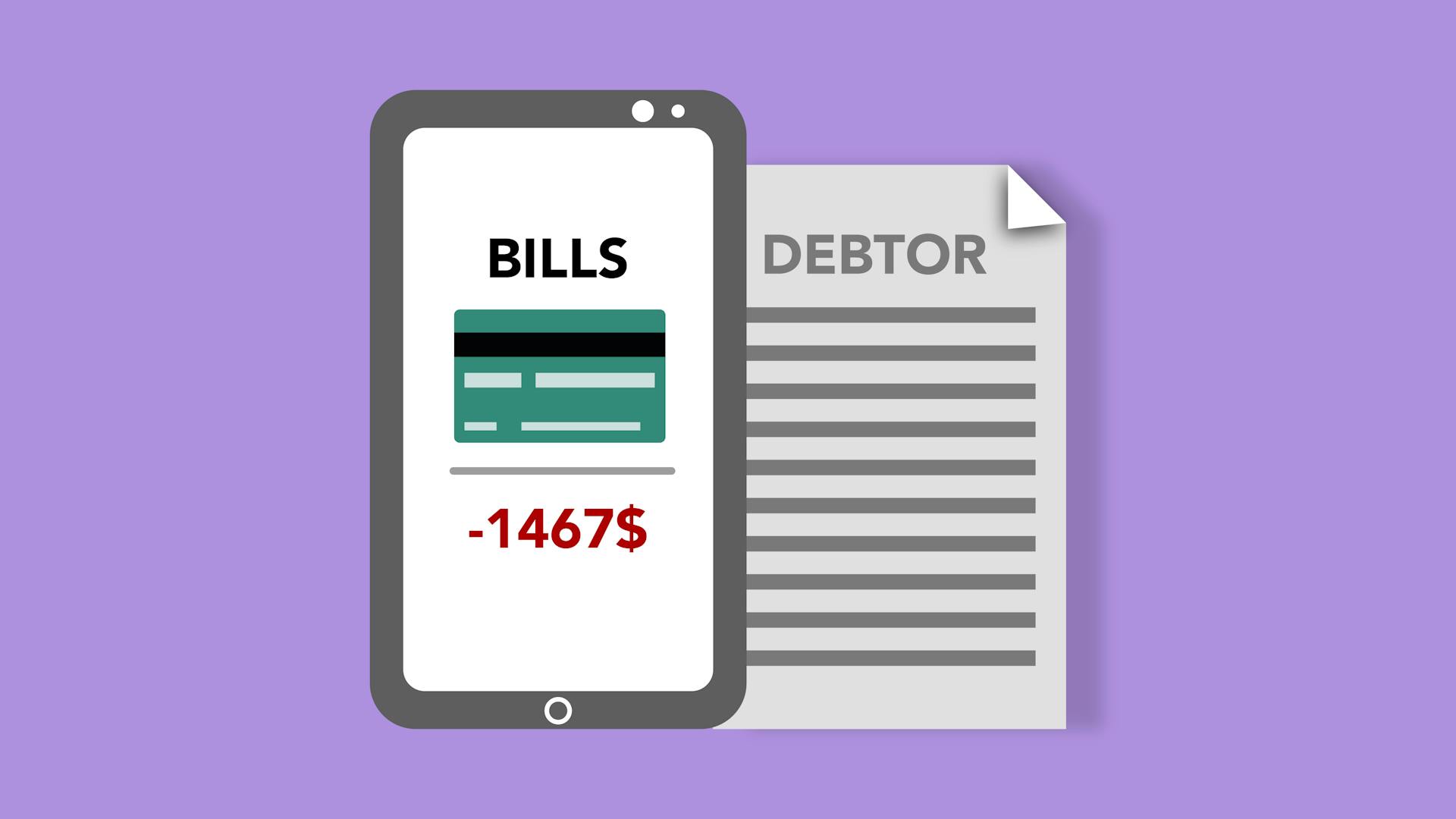
A bad debt to income ratio can have serious consequences on your financial health and credit score. It's essential to understand what a bad debt to income ratio is and how it can impact your life.
For most lenders, a debt to income ratio of 36% or higher is considered high and may indicate a bad debt to income ratio. This means that if you're earning $5,000 per month, you should not have more than $1,800 in debt payments each month.
High debt payments can lead to financial stress and make it difficult to pay bills on time, resulting in late fees and damage to your credit score.
Additional reading: Does Debt to Income Affect Credit Score
What is a Bad Debt-to-Income Ratio?
A debt-to-income ratio above 36% is considered a bad debt-to-income ratio. This is because it indicates that more than one-third of your income is going towards debt payments, making it difficult to afford other expenses.
If your debt-to-income ratio falls between 37% and 42%, you're not in the clear yet. While it's not a bad ratio, it's still a sign that you're carrying too much debt and should start reducing it.
A debt-to-income ratio of 43% to 49% is a warning sign that you're heading for financial trouble. At this level, you're likely to struggle making ends meet, and it's essential to start aggressively paying off your debts.
The danger zone is a debt-to-income ratio of 50% or more. This means that more than half of your income is going towards debt payments, leaving you vulnerable to financial stress and potentially even bankruptcy.
For more insights, see: Profitability Financial Ratios
Calculating and Understanding DTI
Your debt-to-income (DTI) ratio is a crucial financial metric that shows how much of your monthly income goes towards paying off debts. It's calculated by dividing your monthly debt payments by your monthly net income.
To calculate your DTI, start by adding up your monthly debt payments, including credit card debt, auto loans, student loans, and medical bills. Don't include your home mortgage payment in this total.
A DTI ratio of 15 to 20 percent is generally considered ideal. For example, if you have a monthly net income of $2,500 and debt payments of $350, your DTI ratio would be 14 percent ($350/$2,500 = 0.14 or 14%).
Some lenders consider a DTI ratio above 45 to 50 percent to be too high. This is because it may indicate that you're struggling to make debt payments and may be at risk of defaulting on a loan.
How to Calculate Debt-to-Income Ratio
Calculating your debt-to-income ratio is a straightforward process that requires just a few simple steps. To start, you'll need to calculate your monthly household debt payments, which include credit card debt, auto loans, student loans, medical bills, and any other debt you're making a monthly payment on.
Your home mortgage payment is not included in your debt-to-income ratio. Next, calculate your monthly take-home pay, which is your net income. Then, divide the total debt payments per month by your monthly net income. This will give you a number that's less than one, which you can then multiply by 100 to see the percentage of your take-home pay that goes to pay down debt.
For example, if you have a $250 car payment and $100 of monthly credit card payments, and $2,500 net income per month, your debt-to-income ratio would be 14 percent. To do this, add up your total debt payments per month, which in this case is $350 ($250 + $100), and divide that by your monthly net income, which is $2,500.
A unique perspective: Debt to Income Ratio for Second Home
Here's a simple formula to calculate your debt-to-income ratio:
Monthly debt payments ÷ Monthly net income = Debt-to-income ratio
For instance, if your monthly debt payments total $1,540 and your monthly income totals $4,000, your debt-to-income ratio would be 38.5 percent. This is calculated by dividing $1,540 by $4,000 and then multiplying by 100.
It's worth noting that your debt-to-income ratio is not just a number; it's a reflection of your financial health and stability. Lenders use this ratio to determine the risk associated with lending you money, so it's essential to understand how to calculate it and what it means for your financial future.
You might like: Financial Leverage Ratios Formula
Why Use Gross Income in DTI?
Calculating and Understanding DTI: Why Use Gross Income in DTI?
Gross income is used in determining debt-to-income (DTI) because it's your income before taxes and other deductions. This makes it a fairer measure, as taxes and deductions can vary greatly.
To calculate your gross income, you need to add up the amount you receive each month from various sources, including your W-2 job or self-employment, bonuses or overtime, alimony/child support, and other income from various sources.
On a similar theme: Are High Corporate Income Taxes Bad
Lenders consider the following sources of income when calculating DTI: wages, salaries, tips and bonuses, pension, Social Security, child support and alimony, and any other additional income.
For example, if you receive a monthly bonus or overtime pay, it's included in your gross income. This means that even if you don't receive the bonus every month, it's still counted towards your gross income.
Here are the sources of income that lenders consider:
- Wages
- Salaries
- Tips and bonuses
- Pension
- Social Security
- Child support and alimony
- Any other additional income
Impact of DTI on Loan Eligibility and Finances
Your debt-to-income ratio plays a significant role in determining your loan eligibility and financial stability. A low debt-to-income ratio reflects a good balance between your income and debt.
Lenders use your DTI to assess the risk of lending to you. A higher DTI indicates a greater risk, making it harder to get approved for a loan. In fact, most lenders believe that a DTI above 36% can make it difficult to get approved for a mortgage.
For another approach, see: Debt to Income Ratio Auto Loan
Here's a breakdown of how different DTI ranges affect your loan eligibility:
- 36% or less: considered a healthy debt load, ideal for most people
- 37-42%: not bad, but room for improvement
- 43-49%: indicates financial trouble, pay off debts aggressively
- 50% or more: extremely high risk, seek professional help
A DTI of 38.5%, like Sam's, may not be ideal, but it's not a deal-breaker either. However, it's essential to keep an eye on it and make adjustments as needed to maintain a healthy debt load.
How Does Debt Affect Loan Eligibility?
A low debt-to-income ratio reflects a good balance between your income and debt. Lenders calculate your DTI to determine the risk associated with you taking on an additional payment.
Your DTI ratio is calculated by adding up all your regular monthly bills plus an estimated car and insurance payment. For example, if you make $1,900 a month before taxes, and your monthly bills plus an estimated car and insurance payment all add up to $750, your DTI ratio would be 40%.
If your DTI percentage is closer to or above 50%, the best way to improve your DTI ratio is to pay down as much debt as you can. Amounts owed makes up 30% of your FICO credit score, and high credit card balances can greatly affect your DTI ratio and credit score.
Paying off high credit card balances or reducing the debt owed can lower your DTI ratio and improve your chances of getting approved for a bad credit auto loan. The less you owe, the lower your DTI ratio is going to be.
You might enjoy: Insurance Claim Ratio
Why Does DTI Matter?
Your debt-to-income ratio, or DTI, is a key factor in determining your loan eligibility and financial stability. A higher DTI can indicate to lenders that you may struggle to make loan payments.
Lenders use your DTI to assess your ability to pay back a loan successfully. Your DTI shows how likely you are to make mortgage or loan payments comfortably.
Most lenders, including JJ Best, cap the maximum allowed DTI ratio at 45% to 50%. At JJ Best, the lower the percentage, the better off you are in getting an approved loan.
Calculating your DTI ratio helps lenders feel confident in your ability to pay off a loan. It also helps you determine your budget and prepare for loan payments.
A lower DTI ratio signifies that you have a good handle on your finances. This makes you a more attractive borrower to lenders.
Worth a look: A Lower Debt to Total Assets Ratio Is Viewed as
How to Improve DTI
Improving your DTI ratio is crucial to getting approved for a loan, especially a bad credit auto loan. You can calculate your DTI ratio by adding up all your regular monthly bills, including an estimated car and insurance payment, and dividing it by your monthly net income.
If your DTI percentage is above 50%, paying down as much debt as possible is the best way to get it below 50%. High credit card balances can greatly affect your DTI ratio and credit score, making it harder to get approved for a loan.
Paying off high-interest debt or reducing the debt owed can significantly lower your DTI ratio and improve your chances of getting approved for a loan. For example, if you have a $1,900 monthly income and your monthly bills add up to $750, your DTI ratio would be 40%.
Ideally, financial experts like to see a DTI of no more than 15 to 20 percent of your net income. This means that if you have a $250 car payment and $100 of monthly credit card payments, and $2,500 net income per month, your DTI would be 14 percent.
Reducing your debt-to-income ratio can be achieved by paying off debt, consolidating loans, or even negotiating with creditors to lower interest rates. By taking control of your debt, you can improve your credit score and increase your chances of getting approved for a loan.
A fresh viewpoint: How Can I Lower My Debt to Income Ratio
Understanding DTI in Practice
In practice, your DTI is a crucial factor in determining your creditworthiness. A higher DTI indicates that you're more likely to struggle with making loan payments.
Your lender will consider your DTI when deciding whether to approve your loan application. This is because a higher DTI signifies that you have a harder time managing your finances.
A lower DTI, on the other hand, suggests that you have a good handle on your finances. This can give lenders more confidence in your ability to repay your loan.
The ideal DTI varies from lender to lender, but generally, it's recommended to keep your DTI below 36%.
Signs of Trouble
A debt-to-income ratio of 43% or higher is a warning sign that you're in financial trouble.
Lenders consider you a risk if your debt-to-income ratio is too high, and may not approve a loan or extend credit.
Most young adults have a higher debt-to-income ratio after college due to large purchases like cars with a minimum down payment.
A debt-to-income ratio of 2 or 2.5 is generally considered good and achievable with careful financial planning.
You can bring a high personal debt-to-income ratio into acceptable territory by paying down debt and avoiding additional debt over time.
Frequently Asked Questions
Is a 50% debt-to-income ratio good?
A 50% debt-to-income ratio is considered high and may limit your borrowing options, making it challenging to save, spend, or handle unexpected expenses. If you're struggling with debt, it's essential to take action to reduce your DTI ratio and improve your financial stability.
Is a 20% debt-to-income ratio bad?
A debt-to-income ratio of 20% is considered high and may indicate financial strain, but it's not necessarily bad if managed carefully. However, maintaining a lower ratio, ideally below 18%, is generally recommended for a healthier financial situation.
Sources
- https://www.wellsfargo.com/goals-credit/smarter-credit/credit-101/debt-to-income-ratio/dti-faqs/
- https://www.nationaldebtrelief.com/blog/financial-wellness/financial-education/fixing-consumer-debt-to-equity-ratio/
- https://extension.umn.edu/credit-and-debt/how-much-debt-too-much-debt
- https://www.thebalancemoney.com/how-to-calculate-your-debt-to-income-ratio-960851
- https://jjbest.com/what-is-debt-to-income-ratio/
Featured Images: pexels.com


